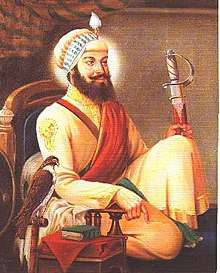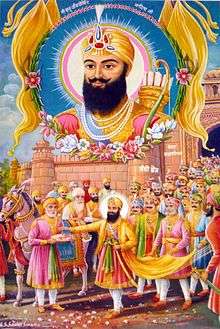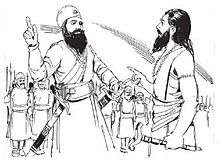Guru Hargobind
Guru Hargobind ([gʊɾuː ɦəɾgoːbɪn̯d̯ᵊ] 19 June 1595 – 3 March 1644), revered as the sixth Nanak, was the sixth of ten Gurus of the Sikh religion. He had become Guru at the young age of eleven, after the execution of his father, Guru Arjan, by the Mughal emperor Jahangir.[5]
Guru Hargobind Sahib Ji | |
|---|---|
 | |
| Other names | The Sixth Master Saccha Paatshah The Master of Miri Piri |
| Personal | |
| Born | Hargobind 19 June 1595 |
| Died | 3 March 1644 (aged 48)[1] |
| Religion | Sikhism |
| Spouse | |
| Children | Baba Gurdita, Baba Suraj Mal, Baba Ani Rai, Baba Atal Rai, Guru Tegh Bahadur, and Bibi Veero |
| Parents | Guru Arjun Dev and Mata Ganga |
| Known for |
Fighting the following battles:
|
| Other names | The Sixth Master Saccha Paatshah The Master of Miri Piri |
| Religious career | |
| Predecessor | Guru Arjan |
| Successor | Guru Har Rai |
| Part of a series on |
| Sikhism |
|---|
 |
|
|
Practices
|
|
|
General topics
|
Guru Hargobind introduced the process of militarization to Sikhism, likely as a response to his father's execution and to protect the Sikh community.[6][7] He symbolized it by wearing two swords, representing the dual concept of miri and piri (temporal power and spiritual authority). In front of the Harmandir Sahib in Amritsar, Guru Hargobind constructed the Akal Takht (the throne of the timeless one). The Akal Takht represents the highest seat of earthly authority of the Khalsa (the collective body of the Sikhs) today.
Biography
Guru Hargobind was born in 1595 in Wadali Guru, a village 7 kilometres (4.3 mi) west of Amritsar,[1][8] the only son of Guru Arjun Dev, the fifth Sikh Guru. He suffered from smallpox as a child. According to hagiographies written by the orthodox Sikh tradition he survived a poisoning attempt by his uncle Prithi Chand, as well as another attempt on his life, when a cobra was thrown at him. He studied religious texts with Bhai Gurdas and trained in swordsmanship and archery with Baba Budda (not to be confused with the Buddha).[1]
On 25 May 1606 Guru Arjan, five days before his own death, selected his son Hargobind as his successor and instructed his son to start a military tradition to protect the Sikh people and always keep himself surrounded by armed Sikhs for protection.[9] Shortly afterwards, Guru Arjan was arrested, tortured and killed by order of the Mughal Emperor Jahangir,[9][10] Guru Hargobind's succession ceremony took place on 24 June 1606.[5][8] He put on two swords: one indicated his spiritual authority (piri) and the other, his temporal authority (miri).[5][11] He followed his martyred father's advice and always kept himself surrounded by armed Sikhs for protection. The number fifty-two was special in his life, and his retinue consisted of fifty-two armed men.[1] He thus founded the military tradition in the Sikh faith.[5][9]
Guru Hargobind had three wives: Damodari, Nanaki and Mahadevi.[1][12] He had children from all three wives. Two of his eldest sons from the first wife died during his lifetime. Guru Tegh Bahadur, his son from Mata Nanaki, became the ninth Sikh Guru.[13]
The Guru was a martial artist (shastarvidya) and he encouraged people to maintain physical fitness and keep their bodies ready for physical combat. He had his own Darbar (court). The arming and training of some of his devoted followers began. The Guru came to possess seven hundred horses and his Risaldari (army) grew to three hundred horsemen and sixty musketeers.[14]
He nominated his grandson to succeed him as the seventh Guru Har Rai. He died in 1644 at Kiratpur Sahib, a town situated on the banks of river Sutlej, and was cremated on the banks of River Sutlej, where now stands Gurdwara Patalpuri Sahib.[1]
Relations with Mughal rulers

Guru Hargobind led the Sikh response against Mughal power after Guru Arjan's execution. He nominally accepted Shah Jahan's authority but resisted the Islamic persecution, fighting four wars against Shah Jahan's armies. His attempts to transform the Sikh community brought him in conflict with the Mughal authority.[7][15]
Jahangir
Along with the execution of Guru Arjan by Mughal Emperor Jahangir, Guru Hargobind from the very start was a dedicated enemy of the Mughal rule. He advised Sikhs to arm and fight the Mughals.[11] The death of his father at the hands of Jahangir prompted him to emphasise the military dimension of the Sikh community. He symbolically wore two swords, which represented miri and piri (temporal power and spiritual authority). He built a fort to defend Ramdaspur and created a formal court, Akal Takht.[16]
Jahangir responded by jailing the 14 year old Guru Hargobind at Gwalior Fort in 1609, on the pretext that the fine imposed on Guru Arjan had not been paid by the Sikhs and Guru Hargobind.[17] It is not clear as to how much time he spent as a prisoner. The year of his release appears to have been either 1611 or 1612, when Guru Hargobind was about 16 years old.[17] Persian records, such as Dabistan i Mazahib suggest he was kept in jail for twelve years, including over 1617–1619 in Gwalior, after which he and his camp were kept under Muslim army's surveillance by Jahangir.[1][18]
It is unclear why he was released. Scholars suggest that Jahangir had more or less reverted to tolerant policies of Akbar by about 1611 after he felt secure about his throne, and the Sunnis and Naqshbandhi court officials at the Mughal court had fallen out of his favour. Another theory states that Jahangir discovered the circumstances and felt Guru Hargobind was harmless, so he ordered his release.[16][17][19]
According to Surjit Singh Gandhi, 52 Rajas who were imprisoned in the fort as hostages for "millions of rupees" and for opposing the Mughal empire were dismayed as they were losing a spiritual mentor. Guru Hargobind requested the Rajas to be freed along with him as well and stood surety for their loyal behavior. Jahangir ordered their release as well. Guru Hargobind got a special gown stitched which had 52 hems. As Guru Hargobind left the fort, the captive kings caught the hems of the cloak and came out along with him.[20]
After his release, Guru Hargobind more discreetly strengthened the Sikh army and reconsolidated the Sikh community.[17] His relations with Jahangir remained mostly friendly. He accompanied Jahangir to Kashmir and Rajputana and subdued Tara Chand of Nalagarh, who had continued for a long time in open rebellion and all efforts to subdue him had failed.[21][22][23] During Jahangir's reign, Guru Hargobind fought a battle against the Mughals at Rohilla. The battle was in response to the militarisation of the Sikhs. The Mughals who were led by Governor Abdul Khan were defeated by the Sikhs.[24]
Shah Jahan
During the reign of Shah Jahan that started in 1627, relations became bitter again. Shah Jahan was intolerant. He destroyed the Sikh baoli at Lahore.[25] In 1628, Shah Jahan's hunting party plundered some of Guru Hargobind's property, which triggered the first armed conflict.[26]
Guru Hargobind's army fought battles with the Mughal armies of Shah Jahan at Amritsar, Kartarpur and elsewhere. Guru Hargobind defeated the Mughal troops near Amritsar in the Battle of Amritsar in 1634. The Guru was again attacked by a provincial detachment of Mughals, but the attackers were routed and their leaders slain.[27] Guru Hargobind also led his armies against the provincial Muslim governors.[28] The Guru anticipated the return of a larger Mughal force, so retreated into Shivalik Hills to strengthen his defenses and army, with a base in Kiratpur where he continued to stay till his death.[26]
Painde Khan was appointed the leader of the provincial troops by Shah Jahan and marched upon the Guru. Guru Hargobind was attacked, but he won this battle as well.[27] Guru Hargobind also fought the Battle of Kartarpur.
Guru Hargobind lost his eldest son Baba Gurdita in 1638. Shah Jahan attempted political means to undermine the Sikh tradition, by dividing and influencing the succession.[26] The Mughal ruler gave land grants to Baba Gurdita's eldest son Dhir Mal, living in Kartarpur, and attempted to encourage Sikhs to recognise Dhir Mal as the rightful successor to Guru Hargobind. Dhir Mal issued statements in favour of the Mughal state, and critical of his grandfather. Guru Hargobind died at Kiratpur Rupnagar, Punjab, on 19 March 1644, but before his death, he rejected his eldest grandson Dhir Mal's politics, and nominated Guru Har Rai (Dhir Mal's younger brother) instead to succeed him as the Guru.[26] The pattern was repeated when Guru Har Rai chose his second son as his successor instead of his eldest son.
Samarth Ramdas and Guru Hargobind

According to Sikh tradition based on an old Punjabi manuscript Panjah Sakhian, Samarth Ramdas met Guru Hargobind (1595–1644) at Srinagar in the Garhval hills. The meeting, corroborated in a Marathi source, Ramdas Swami's Bakhar, by Hanumant Swami, written in 1793, probably took place in the early 1630s during Samarth Ramdas's pilgrimage travels in the north and Guru Hargobind's journey to Nanakmata in the east. It is said that as they came face to face with each other, Guru Hargobind had just returned from a hunting excursion. He was fully armed and rode a horse. "I had heard that you occupied the Gaddi of Guru Nanak", said the Maratha saint Ramdas, and asked what sort of sadhu was he. Guru Hargobind replied, "Internally a hermit, and externally a prince. Arms mean protection to the poor and destruction of the tyrant. Baba Nanak had not renounced the world but had renounced Maya".[29]
Battles and skirmishes
References
- Fauja Singh (2009). "HARGOBIND, GURU (1595–1644)". Encyclopaedia of Sikhism. Punjabi University, Patiala. Retrieved 8 December 2019.
- Gurnek Singh. "DAMODARI, MATA". Encyclopaedia of Sikhism. Punjabi University Patiala. Retrieved 12 August 2017.
- Banerjee, A. C. "NANAKI, MATA". Encyclopaedia of Sikhism. Punjabi University Patiala. Retrieved 12 August 2017.
- Gurnek Singh. "MATA DEVI, MATA". Encyclopaedia of Sikhism. Punjabi University Patiala. Missing or empty
|url=(help) - HS Syan (2013), Sikh Militancy in the Seventeenth Century, IB Tauris, ISBN 978-1780762500, pages 48–55
- John F. Richards (1995). The Mughal Empire. Cambridge University Press. pp. 97–98, 177–178. ISBN 978-0-521-56603-2.
- Hargobind: Sikh Guru, Encyclopedia Britannica, Quote: "Hargobind, sixth Sikh Guru, who developed a strong Sikh army and gave the Sikh religion its military character, in accord with the instructions of his father, Guru Arjan (1563–1606), the first Sikh martyr, who had been executed on the order of the Mughal emperor Jahangir."; "After Jahāngīr’s death (1627) the new Mughal emperor, Shāh Jahān, persecuted the Sikh community in earnest. The Sikhs under Hargobind defeated Shāh Jahān’s armies four times, crushing the myth of Mughal invincibility. To the Sikh ideals of his predecessor, Guru Hargobind thus added another: the right and duty of the Sikhs to defend their faith by the sword if necessary."
- HS Singha (2009), Sikh Studies, Book 7, Hemkunt Press, ISBN 978-8170102458, pages 18–19
- Pashaura Singh (2005), Understanding the Martyrdom of Guru Arjan Archived 20 June 2010 at the Wayback Machine, Journal of Philosophical Society, 12(1), pp. 29–62
- Louis E. Fenech, Martyrdom in the Sikh Tradition, Oxford University Press, pages 118–121
- V. D. Mahajan (1970). Muslim Rule In India. S. Chand, New Delhi, p.223.
- Fenech and McLeod (2014), Historical Dictionary of Sikhism, 3rd Edition, Rowman & Littlefield, ISBN 978-1442236004, page 145
- W. H. McLeod (2009). The A to Z of Sikhism. Scarecrow. p. 88. ISBN 978-0-8108-6344-6.
- Grewal, J.S. Sikh History from Persian Sources: Translations of Major Texts ISBN 978-8185229171, p. 62 "Guru Hargobind, son of Guru Arjan, ate meat and took to hunting. Most of their [the Guru's] followers adopted his practice."
- HS Syan (2013). Sikh Militancy in the Seventeenth Century. IB Tauris. pp. 48–49, 98. ISBN 978-1780762500.
- Phyllis G. Jestice (2004). Holy People of the World: A Cross-cultural Encyclopedia, Volume 1. ABC-CLIO. pp. 345, 346. ISBN 9781576073551.
- Arvind-Pal Singh Mandair (2013). Sikhism: A Guide for the Perplexed. A & C Black. p. 48. ISBN 9781441117083.
- The Sikh Review, Volumes 42–43, Issues 491–497. Sikh Cultural Centre. 1994. pp. 15–16.
- Raj Pal Singh (2004). The Sikhs : Their Journey Of Five Hundred Years. Pentagon Press. pp. 22, 23. ISBN 9788186505465.
- Surjit Singh Gandhi (2007). History of Sikh Gurus Retold: 1606–1708 C.E. Atlantic Publishers & Dist. p. 52. ISBN 9788126908585.
- Jasbir Singh Sarna (2014). The Sikh Shrines in Jammu & Kashmir. p. 28. ISBN 9788186741306.
- Surjit Singh Gandhi (2007). History of Sikh Gurus Retold: 1606-1708 C.E. Atlatic Publishers & Distributors. p. 506. ISBN 9788126908592.
- Joseph Davey Cunningham, H.L.O. Garrett (2012). A History of the Sikhs from the Origin of the Nation to the Battles of the Sutlej. Asian Educational Services. p. 57. ISBN 9788120609501.
- Jaques, Tony (2007). Dictionary of Battles and Sieges. Greenwood Publishing Group. p. 860. ISBN 978-0-313-33536-5. Retrieved 31 July 2010.
- Sikhism Origin and Development By Dalbir Singh Dhillon, p121 "In the year A. D. 1632, Shah Jahan revived his religious policy and issued ... of his policy, the Gurdwara and a Baoli at Lahore was destroyed and a mosque was erected over its place"
- Arvind-Pal Singh Mandair (2013). Sikhism: A Guide for the Perplexed. A & C Black. pp. 48–49. ISBN 9781441117083.
- Cunningham, Joseph Davey. A History Of The Sikhs (1853 ed.). London: John Murray. p. 55.
- Cunningham, Joseph Davey. A History Of The Sikhs (1853 ed.). London: John Murray. p. 53.
- Dr.Ganda Singh (1979). Guru Hargobind and Samarth Ram Das :Punjab Past and Present 13(1). pp. 11, 240–242.
Further reading
- Dr Harjinder Singh Dilgeer (2012), SIKH HISTORY in 10 volumes, Sikh University Press.